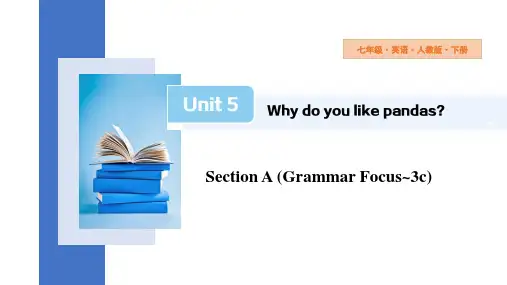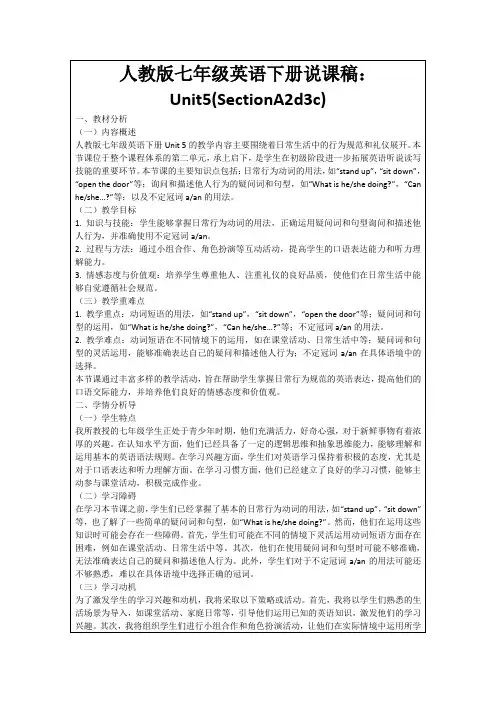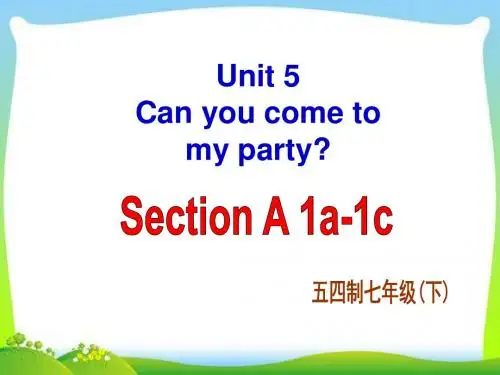人教版英语七下课件unit5-sectiona
合集下载
Unit5SectionA(GrammarFocus3c)课件初中英语人教版新目标七年级下册

◎用法总结:why为特殊疑问词,常见的特殊疑问词总结如 下:
what who
什么 谁
对物、人或事提问 对人物进行提问
how
如何,怎么样 对感受、状况和方式等提问
when
什么时候
对时间提问
what time 几点几分
对时刻提问
how old
几岁
对年龄提问
how many how much
how far how long
(2)I like pandas.(改为否定句) __I__d_o_n_’__t__l_i_k_e__p_a_n_d_a_s_._______
(3)Why do you like pandas?(将主语换成Mike) _W_h_y__d_o_e_s__M_i_k_e__l_i_k_e__p_a_n_d_a_s_?___
把主语I换成he,然后造句。
合作探究
句型学习 ◎学法指导:特殊疑问词就是对句中的某一部分进行提问, 问什么答什么,不可答非所问。
1.仔细阅读教材上Grammar Focus中的句子,然后按照要求 完成下列各题。
(1)请将very、kind of、really按程度从轻到重的顺序排 序。
_k_i_n_d__o_f_,__v_e_r_y_,__r_e_a_l_l_y___
2.以Where开头的特殊疑问句对什么进行提问?用什么回 答? ____对__地__点__、__位__置__进__行__提__问__,_用__表__示__位__置__的__短__语__或__句__子__回__答__。__
3.在谈论一类动物时,要用 _复__数___ 形式表示种类,在回 答中,要注意主语和谓语在 __单__复__数__ 形式上保持一致。
what who
什么 谁
对物、人或事提问 对人物进行提问
how
如何,怎么样 对感受、状况和方式等提问
when
什么时候
对时间提问
what time 几点几分
对时刻提问
how old
几岁
对年龄提问
how many how much
how far how long
(2)I like pandas.(改为否定句) __I__d_o_n_’__t__l_i_k_e__p_a_n_d_a_s_._______
(3)Why do you like pandas?(将主语换成Mike) _W_h_y__d_o_e_s__M_i_k_e__l_i_k_e__p_a_n_d_a_s_?___
把主语I换成he,然后造句。
合作探究
句型学习 ◎学法指导:特殊疑问词就是对句中的某一部分进行提问, 问什么答什么,不可答非所问。
1.仔细阅读教材上Grammar Focus中的句子,然后按照要求 完成下列各题。
(1)请将very、kind of、really按程度从轻到重的顺序排 序。
_k_i_n_d__o_f_,__v_e_r_y_,__r_e_a_l_l_y___
2.以Where开头的特殊疑问句对什么进行提问?用什么回 答? ____对__地__点__、__位__置__进__行__提__问__,_用__表__示__位__置__的__短__语__或__句__子__回__答__。__
3.在谈论一类动物时,要用 _复__数___ 形式表示种类,在回 答中,要注意主语和谓语在 __单__复__数__ 形式上保持一致。
新人教版七下英语unit5 Section A课件

What pet does Peter have?
What pet does Jenny’s
mother have? Peter has a dog.
Jenney’s mom has a cat.
对话角色扮演
2d Read the dialogue again and answer the questions.
有限定范围,特指此动物园 中的panda,故有the
A: Let’s see the pandas first.
B: Why?
A: Because they’re very cute.
练习对话,谈论你喜欢的动物
first.
lovely, strong, tall, nice,cool , friendly, clever…
退出
Unit 5
将单词与图中动物配对
f
c e d b
lion
penguin koala
dolphin tiger giraffe
elephant
panda
pandas lions koalas A: Hello. Do you like …(复数)? dolphins B:Yes, I do . ….. A:Why do you like…?
I (don’t) like … because …
I don’t like koalas because they’re really lazy. I don’t like tigers because they’re very scary. I don’t like lions because they’re really scary.
Make a survey and make a report. Ask your group members their favorite animals and why.
人教版七年级英语下册说课稿:Unit5(SectionA2d3c)

四、教学过程设计
(一)导入新课
为了快速吸引学生的注意力和兴趣,我将以一个趣味小游戏作为新课导入。我会准备一些卡片,上面写着不同的日常行为动词,如“stand up”,“sit down”等。然后,我会邀请一位学生上台,展示一张卡片,并做出相应的动作。其他学生需要迅速模仿这个动作。通过这个游戏,学生们能够在轻松愉快的氛围中复习已知的日常行为动词,同时激发他们对新课的兴趣。
(二)新知讲授
在新知讲授阶段,我会采用逐步呈现知识点的方式,引导学生深入理解。首先,我会通过展示一幅图片或情景,引入一个新的日常行为动词和相关的疑问词和句型。例如,我会展示一幅图片,上面有一个学生在画画,然后我会问学生:“What is he doing?”,并引导他们回答:“He is drawing.”。接着,我会用同样的方法引入其他动词和句型。通过这种方式,学生们能够在具体情境中理解和记忆新的知识点。
人教版七年级英语下册说课稿:Unit5(SectionA2d3c)
一、教材分析
(一)内容概述
人教版七年级英语下册Unit 5的教学内容主要围绕着日常生活中的行为规范和礼仪展开。本节课位于整个课程体系的第二单元,承上启下,是学生在初级阶段进一步拓展英语听说读写技能的重要环节。本节课的主要知识点包括:日常行为动词的用法,如“stand up”,“sit down”,“open the door”等;询问和描述他人行为的疑问词和句型,如“What is he/she doing?”,“Can he/she…?”等;以及不定冠词a/an的用法。
选择这些教学方法的依据是学生的年龄特征和认知水平。青少年学生好奇心强,喜欢尝试新事物,情境教学法和任务型教学法能够激发他们的学习兴趣,培养他们的实践能力。同时,这些方法也能够帮助学生建立起真实的语言环境,提高他们的语言运用能力。
(一)导入新课
为了快速吸引学生的注意力和兴趣,我将以一个趣味小游戏作为新课导入。我会准备一些卡片,上面写着不同的日常行为动词,如“stand up”,“sit down”等。然后,我会邀请一位学生上台,展示一张卡片,并做出相应的动作。其他学生需要迅速模仿这个动作。通过这个游戏,学生们能够在轻松愉快的氛围中复习已知的日常行为动词,同时激发他们对新课的兴趣。
(二)新知讲授
在新知讲授阶段,我会采用逐步呈现知识点的方式,引导学生深入理解。首先,我会通过展示一幅图片或情景,引入一个新的日常行为动词和相关的疑问词和句型。例如,我会展示一幅图片,上面有一个学生在画画,然后我会问学生:“What is he doing?”,并引导他们回答:“He is drawing.”。接着,我会用同样的方法引入其他动词和句型。通过这种方式,学生们能够在具体情境中理解和记忆新的知识点。
人教版七年级英语下册说课稿:Unit5(SectionA2d3c)
一、教材分析
(一)内容概述
人教版七年级英语下册Unit 5的教学内容主要围绕着日常生活中的行为规范和礼仪展开。本节课位于整个课程体系的第二单元,承上启下,是学生在初级阶段进一步拓展英语听说读写技能的重要环节。本节课的主要知识点包括:日常行为动词的用法,如“stand up”,“sit down”,“open the door”等;询问和描述他人行为的疑问词和句型,如“What is he/she doing?”,“Can he/she…?”等;以及不定冠词a/an的用法。
选择这些教学方法的依据是学生的年龄特征和认知水平。青少年学生好奇心强,喜欢尝试新事物,情境教学法和任务型教学法能够激发他们的学习兴趣,培养他们的实践能力。同时,这些方法也能够帮助学生建立起真实的语言环境,提高他们的语言运用能力。
人教版七年级英语下册五四制Unit 5 Section A-1教学课件

•make invitations •decline invitations •accept invitations •talk about obligations
Words and expressions
v.预备;准备 prepare
为……做准备 prepare for
n.考试 exam
去看医生 go to the/ a doctor
Why can’t she come to the party?
She has to visit her grandpa.
Why can’t they come to the party?
They are going to a concert.
1a. Match the phrases with the pictures.
go to a birthday party
Let’s go hiking tomorrow.
Sorry. I have the flu. I have to go to the doctor.
A: Can you swim? B: Yes, I can. /No, I can’t.
A: Can you play football? B: Yes, I can. /No, I can’t.
Can you…
Sure,I’d love to.
Can you come to my party?
Can you…
Can you come to my party?
Sorry ,I can’t. I have to go to the doctor.
Can you…
Can you…
A:Can A: Canyou you yougo come come to tomy my? party? party? A:Can to the mall? A: Can play tennis B: Sure,I’d love to. B:I’m sorry. I have to help my mom. B:I’m sorry. I’m going to the movies. B: Sure,I’d love to.
人教版七年级英语下册教学课件《Unit 5 Section A 2a-2d》

Why don’t you take a walk? 你为什么不去散步呢?
Why don’t you drink some tea? 为什么不喝点茶呢?
“Why don’t you + 动词原形” 的同义句 可以说:Let’s … 例如: Let’s take a walk. 让我们去散步吧。 Let’s drink some tea. 让我们喝点茶吧。
North Pole North America Europe Asia
South America
Africa
Australia Oceania
South PoleCountrຫໍສະໝຸດ AnimalsChina
panda
Australia koalas
South Africa lions
India
elephant
beautiful smart friendly scary
cute
ugly
fun shy
-- What animals do you want to see? -- I want to see…s. -- Why? -- Because they are…
Where are these animals from?
Julie: They’re from __A__u_s_t_r_a_l_ia___.
Well, I like koalas.
Why do you like them?
Because they’re very cute and they are from Australia.
Well, I don’t like lions.
3.____li_o_n_s___ very cute
Why don’t you drink some tea? 为什么不喝点茶呢?
“Why don’t you + 动词原形” 的同义句 可以说:Let’s … 例如: Let’s take a walk. 让我们去散步吧。 Let’s drink some tea. 让我们喝点茶吧。
North Pole North America Europe Asia
South America
Africa
Australia Oceania
South PoleCountrຫໍສະໝຸດ AnimalsChina
panda
Australia koalas
South Africa lions
India
elephant
beautiful smart friendly scary
cute
ugly
fun shy
-- What animals do you want to see? -- I want to see…s. -- Why? -- Because they are…
Where are these animals from?
Julie: They’re from __A__u_s_t_r_a_l_ia___.
Well, I like koalas.
Why do you like them?
Because they’re very cute and they are from Australia.
Well, I don’t like lions.
3.____li_o_n_s___ very cute
人教版英语七下 Unit 5 SectionA 理解【名词的复数形式】的变化规则

boy y baby
以y结 尾
bo bab
4
教学过程
观察词形变化,发现规律。
PROCESS
元音字母+y boy
bo
直接加 s
5
教学过程
观察词形变化,发现规律。
PROCESS
辅音字母+y baby
bab
变y为i再加-es
6
教学过程
PROCESS
读单词,判断下列名词变化的读音。
boys
元音后s读/z/
/bɒɪz/
babies
发/ɪz/
/'beɪbɪz/
7
教学过程
PROCESS
用表格归纳名词复数形式的变化规则。
名词复数形式的变化规
则
条件
改法
读音
"元音字母+y"结尾 直接加-s
读/z/
例词 toys/tɒɪz/
"辅音字母+y"结尾 y为i再加-es
读/ɪz/
ladies/'leɪdɪz/
记忆技巧:元尾s,辅尾要变形
8
达标评测(可选)
考考你
1.用名词的适当形式填空:
TEST
She takes exercise every___d_a来自y_s__(day).9
TEST
达标评测(可选)
考考你
2.读下列句子,并写出名词复数形式的音标:
The cherries __/ɪ_z_/ are quite ripe.
10
人教版英语七下 Unit 5 SectionA
理解【名词的复数形式】的变化规则
教学过程
PROCESS
七年级英语下册Unit5课时2SectionAGrammarFocus_3c课件pptx人教新目标版
一
二
三
四
三、根据表格内容完成对话。(每空一词)
狮子
考拉
熊猫
大象
Jeff
吓人
可爱
安静
巨大
Tom
聪明
懒惰
酷
有趣
Tom: Jeff, what do you think of lions? Jeff: Oh, they are scary. I don’t like them. How about you?
一
二
三
四
are these
( C )2.[2023·雅安期中]—
does he take the
subway to school?
—Because his home is far from his school.
A. How
B. When
C. Why
D. Where
点拨:由答句中的Because可知,问句在询问原因,故应用疑问
UNIT 5 Why do you like pandas?
课时 2 Section A (Grammar Focus-3c)
一、单项选择。 ( C )1.[2023·重庆开州区期中] —
koalas from, Lily?
—Australia. A. When
B. What
C. Where
D. Why
一
二
三
四
leg, cute, follow, also, zoo, ride,panda, for, animal, kind They walk on their back 19. legs and lift(举起)their front legs to ask 20. for food. They like cakes very much. Do you like 21. pandas ? There’s only one in the zoo. Her name is Lingling. She is very 22. cute .
人教版七年级下册英语Unit 5 SectionA (1a-2d)
Unit5 Whydoyoulikepandas?
第一课时:SectionA (1a-2d)
Let’senjoyasongandsaywhatanimalscanyouseeinthevideo?
1a
LanguageGoals:Describeanimals; Expressreferences
【点拨】用交际法解题。Notatall. 意为“别客气。”; Nevermind. 意为“没关系。”;Itdoesn’tmatter. 意为“没 关系。”;Goodidea. 意为“好主意。”。上句“测试后 让我们去看电影吧。” 表示建议,四个选项中只有D项可 作为对其的回答,表示同意、支持对方的建议。
【点拨】用语法分析法解题。第一空填基数词,指“四个 孩子”;第二空填序数词,指“他的第一个孩子”。
知识点 3 They’remyfavoriteanimals.
考点5 animal/ænɪml/n. 动物 e.g. Canyouseeananimalinthetree? 你能看见树上有一只动物吗?
知识点 4 Becausethey’reverycute.
考点6 because/bɪkɒz/conj. 因为 e.g.
TheybelieveHuaweibecauseitisoneofthebiggestsm artphonemakersintheworld. 他们相信华为,因为它是世界上最大的智能手机制 造商之一。
考点2 交际用语
“Let’s+动词短语.”意为“咱们……吧。” 它是以Let’s开头的祈使句,是提建议的句型。 Let’s是Letus的缩写,其后接动词原形作宾 语补足语。常用的肯定答语有“OK./Allright./ Goodidea.”;否定答语可用“Sorry,I...”。
第一课时:SectionA (1a-2d)
Let’senjoyasongandsaywhatanimalscanyouseeinthevideo?
1a
LanguageGoals:Describeanimals; Expressreferences
【点拨】用交际法解题。Notatall. 意为“别客气。”; Nevermind. 意为“没关系。”;Itdoesn’tmatter. 意为“没 关系。”;Goodidea. 意为“好主意。”。上句“测试后 让我们去看电影吧。” 表示建议,四个选项中只有D项可 作为对其的回答,表示同意、支持对方的建议。
【点拨】用语法分析法解题。第一空填基数词,指“四个 孩子”;第二空填序数词,指“他的第一个孩子”。
知识点 3 They’remyfavoriteanimals.
考点5 animal/ænɪml/n. 动物 e.g. Canyouseeananimalinthetree? 你能看见树上有一只动物吗?
知识点 4 Becausethey’reverycute.
考点6 because/bɪkɒz/conj. 因为 e.g.
TheybelieveHuaweibecauseitisoneofthebiggestsm artphonemakersintheworld. 他们相信华为,因为它是世界上最大的智能手机制 造商之一。
考点2 交际用语
“Let’s+动词短语.”意为“咱们……吧。” 它是以Let’s开头的祈使句,是提建议的句型。 Let’s是Letus的缩写,其后接动词原形作宾 语补足语。常用的肯定答语有“OK./Allright./ Goodidea.”;否定答语可用“Sorry,I...”。
人教版七年级英语下册教学课件《Unit 5 Section A Grammar Focus-3c》
like the mobile phone game so much?
A.what
B.why
C.how
句意为“你知道学生们为什么那么喜欢手机 游戏吗?” 故选B。
✓ Remember the sentences in the Grammar Focus.
✓ Write five sentences about your favorite animals.
1. 你为什么喜欢熊猫? W__h_y__d_o__y_o_u__l_ik_e__p_a_n_d__a_s_?_____________
2. 因为它们是有趣的。 _B_e_c_a_u_s_e__t_h_e_y_’r_e__k_i_n_d__o_f__in_t_e_r_e_s_t_i_n_g_.___
-- _____.
A. Lions
B. Pandas
C. Koalas
D. Dolphins
2. --Are ____ from China? --Yes, they are.
A. lions C. koalas
B. pandas D. dolphins
3. --Do you like giraffes?
Because they’re ______.
They’re from _______.
They’re ______.
My partner, A’s favorite animal is elephants. He thinks they’re cute. They’re from Africa. They’re grey. B’s favorite animal is pandas. He thinks they’re interesting. They’re from China. They’re white and black.
人教版七年级下册英语Unit 5 SectionA (Grammar Focus-3c)
A:Istheanimalbig?
B:Yes, itis.
A:Where'stheanimalfrom?
B:It'sfromChina.
A:Isitblackandwhite?
B:Yes, itis.
A:It'sapanda!
B:Yes, you'reright!
知识点 ButIliketigersalot.
典例 —IfeelupsetbecauseIamtooheavy. —________domoreexercisetolosesomeweight? B [郴州] A. Whydon‘t B. Whynot C. Whynotto
典例 —WhynotholdaChinesePoetryCompetition (诗歌比赛) towelcomeourmotherland’s70thbirthday?
Ilike________becausethey'reinteresting. Idon'tlike________becausethey'relazy.
3c
Thinkofananimal.
Askandanswerquestionswithyourpartnertoguesseach
other'sanimal.
【点拨】 “the+形容词” 表示一类人或事物,此处指“ 年轻人”。
一、单项选择
1.—Whyareyoulateforclass?
—______Ididn’tcatchthebus. A. BecauAseB. AndC. SoD. But
2.—______doyoulikeWolfWarriorⅡ (《战狼Ⅱ》)?
- 1、下载文档前请自行甄别文档内容的完整性,平台不提供额外的编辑、内容补充、找答案等附加服务。
- 2、"仅部分预览"的文档,不可在线预览部分如存在完整性等问题,可反馈申请退款(可完整预览的文档不适用该条件!)。
- 3、如文档侵犯您的权益,请联系客服反馈,我们会尽快为您处理(人工客服工作时间:9:00-18:30)。
do
2. 来自 be/come
from
3. 稍微;有点儿 kink of 4. 黑白相间的 black and 5. 整天 all 6. 南非 South day
withe
Africa
名师点津
【1】Let'ssee the pandas first. 让我们先看大熊猫吧。 【知识点】let's do sth. 的用法;first 的用法 【讲解1】本句是祈使句。let为使役动词,后接动词原形 作宾语补足语。其结构为:Let's do sth. ,意为“让我们做 某事吧”,表示说话人的建议。常用的肯定答语有“OK. /All
(2)kinds of意为“各种各样的”,后面接名词,相当
【讲解2】be from 意为“来自……;从……来”。其中be
是连系动词,有人称和数的变化。其同义短语为 come
from。如: He is from Hong Kong. =He comes from Hong Kong. 他来自香港。 【学以致用】 ( D ) Half the doctors in the hospital Beijing. A. comes fromB. is from C. be fromD. come from
【讲解2】want (sb. ) to do sth. 表示“想要(某人)做某事”
。want后面接动词的不定式结构。如:
My mom wants me to stay at home. 我妈妈想让我待
在家里。
【学以致用】
( B )1. I want you my best friend.
A. be
【知识点】where引导的特殊疑问句的用法;be from的
用法
【讲解1】这是一个由where 引导的特殊疑问句,即
“Where+be+主语+from?”句型,回答时,介词from 后面
常接表示国家、城市等的地点名词。如:
—Where is Wang Yuan from?王源来自哪里?
—He is from Chongqing. 他来自重庆。
right. /Good idea. ”等,否定答语可用“Sorry, I…”。如:
—Let's sing an English song. 让我们唱一首英文歌吧
。
—Good idea. 好主意。/Sorry, I can't sing English
songs. 对不起,我不会唱英文歌曲。
【辨析】let's 与let us
The first thing for us is to learn English
well. 对我们来说,首要的事就是学好英语。
【学以致用】 ( D ) The teacher let the boy it again.
A. does B. did C. to do D. do
【2】—Why do you want to see them? 你为什么想 看它们? —Because they‘re interesting. 因为它们很有趣。 【知识点】why引导的特殊疑问句的用法;want to do
C. are
B. to be
D. being
( A )2. I'm writing to you I'm afraid to talk about it face to face. A. Because C. Until B. though D. so
【3】Whereare they from?它们来自哪里?
家吧。(表请求允许,不包括邓老师在内)
【讲解2】此句中的first不是序数词“第一”,而是副
词“首先”,用来表示顺序,可置于句尾或句首。如:
Let the girls come in first. 让女孩们先进来。
【辨析】first 还可以用作形容词,意为“第一的;最初
的;首要的”,常用作定语。如:
let's 是let us 的缩写。一般情况下,let's 与let us 表达的意思一样,都为“让我们”,但两者也有区别: (1)let's 强调包括说话人和对方在内,用来提出建 议。如: Let's go to school, Xiaomei. 小梅,我们去上 学吧。 (2)let us不包括对方,用来请求允许。如: Let us go home, Mrs. Deng. 邓老师,让我们回
广东学导练 英语
七年级
下册
配人教(新目标)版
Unit 5
Why do you like pandas?
Section A
课前预习
一、重点单词
1.
2.
panda 熊猫 zoo tiger 动物园
3.
老虎
4. elephant 大象
5.
6.
lion
狮子
giraffe 长颈鹿
7. 8.
animal 动物 cute 可爱的;机灵的
9.
10. 11.
lazy
smart
懒散的;懒惰的
聪明的
beautiful 美丽的;美好的
kind
12.
13.
种类
Australia 澳大利亚
14. 15.
south Africa
adj. 南方的 n. 南;南方 非洲
16.
17. 18.
pet
leg
宠物
腿 猫
cat
sleep
19.
睡觉
二、重点短语 1. sth. 想要做某事 want to
【4】Well, because she‘s kind of boring. 好吧,因为
她
【讲解1】kind of意为“稍微;有点儿”,相当于a little。 如: The movie is kind of exciting. 这部电影有点刺激。 【辨析】kind of 与 kinds of (1)kind of意为“稍微;有点儿”,后面接形容词,相当 于a little/bit。如: I'm kind of hungry. 我有些饿了。
sth. 的用法
【讲解1】该问句是由疑问词why引导的特殊疑问句,用 来询问原因。句式结构为“Why +一般疑问句”,其答语一 般由because引导。如: He didn't go because it was raining. 因为下雨,
所以他没去。
注意:because与so不能同时使用。because 引导原 因,而so 引导的是结果。
